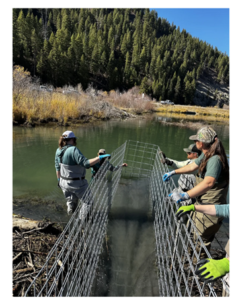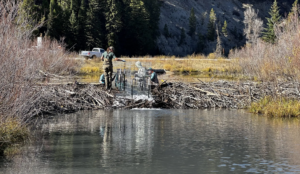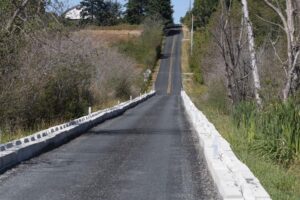It’s nice to see Colorado comfortable with flow devices.
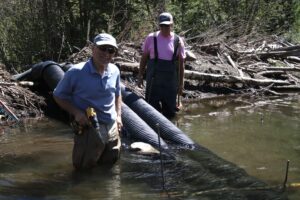 The Tuesday after Labor Day, a few volunteers worked as busily as beavers, wading knee deep into dammed waters along North Tenmile Creek in Frisco.
The Tuesday after Labor Day, a few volunteers worked as busily as beavers, wading knee deep into dammed waters along North Tenmile Creek in Frisco.
A chainsaw, three corrugated plastic pipes, wire and rebar lay around the picnic table where Alton Penz and Frank Pricci worked. Nearby, cars whizzed down the Interstate 70 offramp, some pulling into the busy parking lot adjacent to the recpath that runs along Tenmile Creek.
Nestled in the creek behind the parking lot’s bathroom, some North American beavers have quietly constructed their home in the shadow of Mount Royal just off Frisco’s Main Street. But the semi-aquatic rodents have become something of a nuisance.
As the beavers have built up their dam, the water levels have threatened the picnic areas and, more importantly, the cement foundation of a large power pole, Frisco grounds foreman Chris Johnsen said. The public works department has periodically gone in to remove some of the debris built up in the dam to allow more water to flow through, but that’s not a long-term fix when there are industrious dam-builders nearby.
The beaver deceiver Penz and Pricci built Tuesday aims to be a more permanent solution. The contraption pipes water through the center of the dam — tricking the beavers so water keeps flowing even as they continue to build the dam higher.
“Public works, they’re happy to have the beavers as long as they don’t do damage,” Penz said. “There are a lot of beavers in Summit County. So if they trapped them out of a given pond, there will be more back in a year or two. It isn’t a long-term solution to trap them. It isn’t a long-term solution to keep ripping the dam apart.”
Well that’s something I’d like to hear every public works crew say. Especially in Martinez. You must be naturals.
Colorado is home to a robust beaver population. The rodents are habitat engineers, cutting aspens, willows and other trees, and their dams slow water, which recharges groundwater, reduces erosion, provides a barrier to wildfires and provides other ecological benefits, according to Colorado Parks and Wildlife. But those dam-building skills can also cause conflicts with humans, blocking culverts and flooding roads and other property.
For the past five years or so, Frisco has not been trapping and relocating beavers but instead has been working to coexist happily with the creatures, Johnsen said. The grounds foreman said he has forged something of a friendship with Penz and Pricci while they have helped deal with the beaver community over the years.
Penz first contacted the public works department several years ago, looking to construct beaver deceivers downstream of the large pond at Walter Byron Park. He said he lives above the park and watches the wildlife in the wetlands there, so he pitched the deceivers as an alternative to trapping the beavers there.
“I can just see all the wildlife that is in there. It’s phenomenal,” Penz said. “There are people playing down in Walter Byron and there are moose up there in the wetlands, or there is a bear taking a nap in there. You have foxes and muskrats that live in the ponds. You have birds of all kinds nesting in there. It creates this incredible natural environment.”
Wow that’s a friendship made in heaven. Some beaver believers with tools and waders and a public works crew that can see the benefit of letting folks help them.
Penz and Pricci helped create three beaver deceivers at Walter Byron Park, which have only required occasional monitoring.
“We did one and it worked,” Penz said. “Then we discovered (the beavers) were trying to build a dam down by the volleyball courts. So we put another one in, and that one worked. And then they were trying to build another dam further behind the volleyball court. That one was a larger stream, so we had to go to a 10-inch pipe.”
Well you’re dam plucky. I’ll give you that. Although the pragmatist in me wonders whether it’s possible those devices weren’t compromises enough with the beaver to allow the water to be a safe height and that’s why you had to keep chasing them downstream with three flow devices. Remember a device “WORKS” when it drains water from the pond BUT not soo much water that the beavers have to start over somewhere else.
It’s a happy compromise. Not a checkerboard.
The beaver deceiver Penz and Pricci built Tuesday along the Tenmile Creek was perhaps the trickiest the duo has built yet. It consists of three 10-inch diameter pipes for a total of 90 square inches of drainage, Penz said. Each pipe extends 16 feet above the dam, then bends at the top of the dam to throw the water several feet off the end.
“We’re going to put a 4-foot throw on the other side,” Penz said. “So the beavers, in order to plug it up, they’d need wings. They’d have to fly up. It’s hanging off the other side.”
But that’s only half the deception. On the uphill side of the dam, the two “beaver deceiver weavers” secured the pipes to the bottom of the stream with wire and rebar before placing a large metal cage over the openings to the pipes. The cage helps prevent the beavers from creating a dam around the pipes.
“What happens, then, is (the beavers) unwittingly incorporate the pipe into the dam,” Penz said. “They’ll build the dam higher but it won’t have any effect because the height of that pipe on the top of the dam determines the height of the pond. That’s the deception.”
The Frisco Public Works Department tore a small hole in the beaver dam Tuesday morning to allow the water levels to drop enough for Penz and Pricci to work. Then, further toward the center of the dam, the two volunteers had to deconstruct enough of the beaver dam to insert the pipes.
I’m not feeling totally confident about this. Didn’t every flow device need the intake of the pipes to be protected with wire? And why do you keep calling them deceivers? I’m starting to suspect that you folks weren’t trained by the beaver institute OR Sherri Tippie.
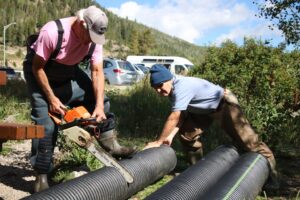 From there, a great deal of whirling of power tools and finagling with piping ensued. Pricci said the two men had an “impossible time,” pinning the pipe to the bottom of the creek. Fish, including some 10-inch long trout, swam around their ankles as they worked.
From there, a great deal of whirling of power tools and finagling with piping ensued. Pricci said the two men had an “impossible time,” pinning the pipe to the bottom of the creek. Fish, including some 10-inch long trout, swam around their ankles as they worked.
But, by the afternoon, the two busy beavers had wrapped up their work, leaving the real beavers to enjoy their mountainside lodge, hopefully without causing further issues for the town.
“The notion is deceivers work because it manages beavers’ behavior so that they don’t do the damage but they can still be there — and they create these phenomenal natural environments,” Penz said. “It’s why we have moose in town, because there are all these wetlands around.”
Okay. You have the right motivation and the right skill set and a good enough connection with public works. But anchoring the pipe to the cage and making it stay down are part of the job. Maybe we can just get you a little more training with the beaver institute? Just some tweaking and finer points….
So you can work smarter not harder?
 To humans it’s a culvert. But for beavers living near Todd Weiler’s Emsdale, Ont., driveway, it’s a poorly built dam with an 18″ hole, just begging to be plugged
To humans it’s a culvert. But for beavers living near Todd Weiler’s Emsdale, Ont., driveway, it’s a poorly built dam with an 18″ hole, just begging to be plugged

